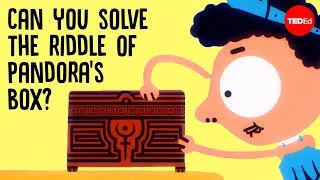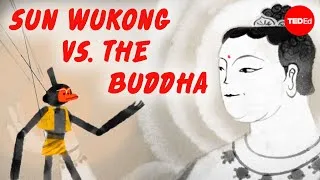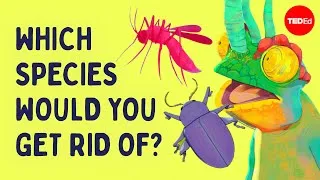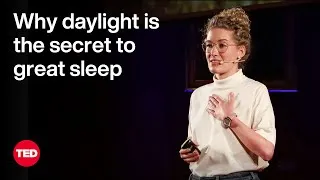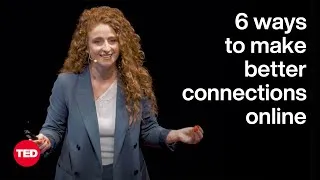Is light a particle or a wave? - Colm Kelleher
Colm Kelleher:光,是粒子還是波?
1,713,383 views ・ 2013-01-17
請雙擊下方英文字幕播放視頻。
00:00
Translator: Andrea McDonough
Reviewer: Bedirhan Cinar
0
0
7000
譯者: Elmo Wu
審譯者: Jephian Lin
00:14
You look down and see a yellow pencil lying on your desk.
1
14603
3482
當你低下頭,望著桌上的黃色鉛筆。
00:18
Your eyes, and then your brain, are collecting
2
18085
2300
你的眼睛,然後是你的腦袋,便開始接收
00:20
all sorts of information about the pencil:
3
20385
2615
各式各樣有關它的資訊:
00:23
its size,
4
23000
566
00:23
color,
5
23566
524
它的大小、
顏色、
00:24
shape,
6
24090
430
00:24
distance,
7
24520
752
形狀、
與你的距離、
00:25
and more.
8
25272
1403
及其他各種特徵。
00:26
But, how exactly does this happen?
9
26675
2215
不過,這一切到底是怎麼發生的?
00:28
The ancient Greeks were the first
10
28890
1154
古希臘人率先開始
00:30
to think more or less scientifically
11
30044
1714
以稍加科學的角度思索
00:31
about what light is and how vision works.
12
31758
2643
什麼是光,視覺究竟又如何運作。
00:34
Some Greek philosophers,
13
34401
883
某些希臘哲學家,
00:35
including Plato and Pythagoras,
14
35284
2144
包括柏拉圖和畢達哥拉斯在內,
00:37
thought that light originated in our eyes
15
37428
1906
認為光其實源自人的眼睛
00:39
and that vision happened when little, invisible probes
16
39334
2602
而當眼睛發送
肉眼看不見的微小探測器
00:41
were sent to gather information about far-away objects.
17
41936
2912
去收集遠處物體的資訊時,便產生視覺。
00:44
It took over a thousand years
18
44848
1334
直到一千年後
00:46
before the Arab scientist, Alhazen,
19
46182
2223
阿拉伯科學家海什木才表示
00:48
figured out that the old, Greek theory of light couldn't be right.
20
48405
3714
古希臘的光學理論完全不合邏輯。
00:52
In Alhazen's picture, your eyes don't send out
21
52119
2804
海什木認為,人的眼睛根本不會發送
00:54
invisible, intelligence-gathering probes,
22
54923
2089
任何迷你情資探測器,
00:57
they simply collect the light that falls into them.
23
57012
3164
眼睛只是接收
射進來的光線。
01:00
Alhazen's theory accounts for a fact
24
60176
2145
海什木的理論
解開了希臘人
01:02
that the Greek's couldn't easily explain:
25
62321
2245
「為何有時會一片漆黑」的不解之謎。
01:04
why it gets dark sometimes.
26
64566
2327
「為何有時會一片漆黑」的不解之謎。
01:06
The idea is that very few objects actually emit their own light.
27
66893
3902
理論指出,本身會發光的物體並不常見。
01:10
The special, light-emitting objects,
28
70795
2314
會發光的物體相當特別,
01:13
like the sun
29
73109
982
如太陽
01:14
or a lightbulb,
30
74091
846
01:14
are known as sources of light.
31
74937
2569
或是燈泡,
我們稱之為光源。
01:17
Most of the things we see,
32
77506
1218
我們目光所及絕大部分的東西,
01:18
like that pencil on your desk,
33
78724
1606
例如桌上的鉛筆,
01:20
are simply reflecting light from a source
34
80330
2565
都只是反射光線
01:22
rather than producing their own.
35
82895
1875
本身並不會發光。
01:24
So, when you look at your pencil,
36
84770
2015
因此,當你望著你的鉛筆
01:26
the light that hits your eye actually originated at the sun
37
86785
2825
映入眼簾的
其實是鉛筆反射了
01:29
and has traveled millions of miles across empty space
38
89610
2979
穿越百萬英里
01:32
before bouncing off the pencil and into your eye,
39
92589
2815
源自太陽的光線,
01:35
which is pretty cool when you think about it.
40
95404
2212
想一想其實還蠻有意思的。
01:37
But, what exactly is the stuff that is emitted from the sun
41
97616
2797
不過,太陽散發出的究竟是什麼東西
01:40
and how do we see it?
42
100413
1721
我們又如何看得到?
01:42
Is it a particle, like atoms,
43
102134
1751
是如原子般的微小粒子?
01:43
or is it a wave, like ripples on the surface of a pond?
44
103885
3633
還是如池塘漣漪般的波?
01:47
Scientists in the modern era would spend a couple of hundred years
45
107518
2859
近代科學家耗時數百年
01:50
figuring out the answer to this question.
46
110377
2281
試圖找出真相。
01:52
Isaac Newton was one of the earliest.
47
112658
1771
艾薩克.牛頓是最早開始找尋答案的科學家之一。
01:54
Newton believed that light is made up
48
114429
1757
牛頓相信
01:56
of tiny, atom-like particles, which he called corpuscles.
49
116186
3922
光是由原子般、他稱之為光子的
微小粒子組成。
02:00
Using this assumption, he was able to explain some properties of light.
50
120108
3876
這項假設足以解釋光的某些特性。
02:03
For example, refraction,
51
123984
1394
例如折射,
02:05
which is how a beam of light appears to bend
52
125378
2360
折射是指光由空氣進入水時
02:07
as it passes from air into water.
53
127738
2006
所產生的彎曲現象。
02:09
But, in science, even geniuses sometimes get things wrong.
54
129744
4121
不過,在科學界,即使是天才也會犯錯。
02:13
In the 19th century, long after Newton died,
55
133865
2818
牛頓過世很長一段時間後,在十九世紀
02:16
scientists did a series of experiments
56
136683
2105
科學家們做了一系列實驗
02:18
that clearly showed that light can't be made up
57
138788
2584
清楚證明
02:21
of tiny, atom-like particles.
58
141372
2593
光,不可能由原子般的微小粒子組成。
02:23
For one thing, two beams of light that cross paths
59
143965
2935
仔細想想也對,兩道光束交錯時
02:26
don't interact with each other at all.
60
146900
2444
完全不會互相影響。
02:29
If light were made of tiny, solid balls,
61
149344
2367
如果光是由微小、實心的球體組成,
02:31
then you would expect that some of the particles from Beam A
62
151711
2931
我們可以預期 A 光束的微小粒子
02:34
would crash into some of the particles from Beam B.
63
154642
2743
會與 B 光束的微小粒子產生撞擊。
02:37
If that happened, the two particles involved in the collision
64
157385
2494
當兩邊的粒子發生碰撞
02:39
would bounce off in random directions.
65
159879
2331
粒子則會不規則地四處彈跳。
02:42
But, that doesn't happen.
66
162210
1477
不過事實並非如此。
02:43
The beams of light pass right through each other
67
163687
1940
兩道光束反而會直接互相穿越,
02:45
as you can check for yourself
68
165627
1050
你可以自行
02:46
with two laser pointers and some chalk dust.
69
166677
2262
用雷射筆和粉筆灰實驗看看。
02:48
For another thing, light makes interference patterns.
70
168939
2505
另外,光會有「干涉」的現象。
02:51
Interference patterns are the complicated undulations that happen
71
171444
3502
干涉指的是兩列波在空間中重疊時
02:54
when two wave patterns occupy the same space.
72
174946
3035
產生新的複雜波形的現象。
02:57
They can be seen when two objects
73
177981
1550
我們可以在
02:59
disturb the surface of a still pond,
74
179531
2224
兩個物體丟進靜止的池塘時,
03:01
and also when two point-like sources of light
75
181755
2450
或是兩道點狀光束放得很近時,
03:04
are placed near each other.
76
184205
2189
觀察到這種現象。
03:06
Only waves make interference patterns,
77
186394
1742
只有波才會互相干涉,
03:08
particles don't.
78
188136
1500
粒子不會。
03:09
And, as a bonus, understanding that light acts like a wave
79
189636
3356
更有甚者,把光理解為一種波
03:12
leads naturally to an explanation of what color is
80
192992
3000
便自然而然能夠解釋,什麼是顏色,
03:15
and why that pencil looks yellow.
81
195992
1703
又鉛筆為何看起來是黃色的。
03:17
So, it's settled then, light is a wave, right?
82
197695
3341
結論,光是一種波,對吧?
03:21
Not so fast!
83
201036
1651
先別急!
03:22
In the 20th century, scientists did experiments
84
202687
2691
二十世紀時,科學家實驗發現
03:25
that appear to show light acting like a particle.
85
205378
3054
光亦有一些粒子的特性。
03:28
For instance, when you shine light on a metal,
86
208432
2712
例如,當照在金屬上時
03:31
the light transfers its energy to the atoms in the metal
87
211144
3258
光會將能量由
一種叫「量子」的形式
03:34
in discrete packets called quanta.
88
214402
2697
分批傳遞至金屬中的原子。
03:37
But, we can't just forget about properties like interference, either.
89
217099
3702
不過,我們還是不能忽略如干涉這種波獨有的特性。
03:40
So these quanta of light aren't at all like
90
220801
2365
這些量子畢竟還是
03:43
the tiny, hard spheres Newton imagined.
91
223166
2833
與牛頓所想像的微小、實心球體有所不同。
03:45
This result, that light sometimes behaves like a particle
92
225999
2753
這讓光表現得時而像粒子,
03:48
and sometimes behaves like a wave,
93
228752
2390
時而像波,
03:51
led to a revolutionary new physics theory called
94
231142
2260
使得物理學界產生了革命性的新理論
03:53
quantum mechanics.
95
233402
2250
「量子力學」。
03:55
So, after all that, let's go back to the question,
96
235652
2947
所以,最後還是要回歸最初的問題:
03:58
"What is light?"
97
238599
1476
「光是什麼?」
04:00
Well, light isn't really like anything
98
240075
2398
光,其實獨樹一格,
04:02
we're used to dealing with in our everyday lives.
99
242473
2429
與我們日常生活接觸的事物都有所不同。
04:04
Sometimes it behaves like a particle
100
244902
1831
有時它的特性像粒子,
04:06
and other times it behaves like a wave,
101
246733
2286
有時又像波,
04:09
but it isn't exactly like either.
102
249019
2711
但與兩者
卻都不完全相同。
New videos
關於本網站
本網站將向您介紹對學習英語有用的 YouTube 視頻。 您將看到來自世界各地的一流教師教授的英語課程。 雙擊每個視頻頁面上顯示的英文字幕,從那裡播放視頻。 字幕與視頻播放同步滾動。 如果您有任何意見或要求,請使用此聯繫表與我們聯繫。


